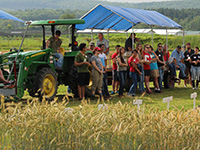Home | Unit 2
Overview
In the activity, youth will gain an understanding of the importance of a community or school garden project, in helping to mitigate climate change. They will reflect on different gardening practices they are doing and why these help the climate and the overall importance of sustainable gardening practices.
Skill Level
Intermediate; See Variations for Beginner and Advanced Level
Learner Outcomes, Youth will:
- Recognize the relationships between personal actions, evidence of global warming, climate change facts and sustainable methods.
- Explore different actions and methods that foster sustainability in the natural world and promote sustainability in the garden.
- Evaluate a garden site and create a garden design that supports sustainability and identify ways to address and limit climate change
- Contribute to the community by initiating daily actions and taking responsibility in addressing climate change issues.
- Connect with others to formulate solutions for sustainability.
Education Standards
- NS.5-8.3 Life Science: Structure and function in living systems, Populations and ecosystems
- NS.5-8.6 Personal and Social Perspectives: Populations, resources, and environments
Success Indicators
Youth reflect on current gardening practices and brainstorm to improve sustainability.
Life Skills
Healthy lifestyle choices, goal setting, planning, wise use of resources, resiliency
Time Needed
30 minutes
Materials List: Garden, flip chart and markers, enough sketch paper and pencils, colored pencils or markers for small group work. For Intermediate and Advanced skill levels: measuring tape, rulers. Facilitator references: Composting and Vermicomposting Q&A’s, Sustainable Gardening Practices Poster; Youth handouts: Site Assessment Surveys, one for each small group.
Youth Handout
Leader Handouts
Composting and Vermicomposting FAQ’s; and Sustainable Garden Practices Soil Posters
Additional Composting Resources
Composting Flyer and Home Composting Brochure
Space
A garden that the group has been working in, or a school or community garden they can visit. A place for youth to make drawings and sketches.
Suggested Group Size
12-15 or more
Acknowledgements
Adapted from Climate Change in the Garden: One Seed at a Time: Sustainable gardening practices: Learn about the importance of sustainable gardening practices, Cornell Garden-Based Learning by Dina El-Mogazi.
Cornell Garden-Based Learning Library, Cornell Cooperative Extension, Dutchess County, CCE County Educators: Composting and Vermicomposting Q&A’s
Introduction
Youth will gain an understanding of the importance of a community or school garden project, in helping to mitigate climate change. They will reflect on different gardening practices they are doing and why these help the climate and the overall importance of sustainable gardening practices.
Opening Questions
In what ways do you see that gardening helps us improve the environment? Each gardening practice has its own story; how do you see them helping in their own way, to reduce human impact and lessen climate change? What are we doing here in this [or our own] garden, that is making a difference in slowing down climate change?
Background Information
Sustainability encompasses actions we can take, such as recycling, repurposing, composting, greening the world and keeping our valuable resources intact. In Climate Change in the Garden, which is a subtopic in the Exploring Sustainability activities, youth will gain a greater understanding of what sustainability and resiliency are though gardening. In this topic, you will find relevant links, lessons and resources for garden-based learning and inquiry.
Before the Activity: Prepare materials and handouts; Review handouts, composting and vermicomposting FAQ’s for background information.
Let’s Do It!
Take the group out into the garden, share the Sustainable Gardening Poster and ask the opening questions:
- What they have been learning about climate change and how it affects us and our environment.
- In what ways does gardening improve the environment? Allow them to first think generally, in broad terms.
- Ways that growing a garden makes a big difference in helping to mitigate climate change.
- How each gardening practice helps in its own way, to lessen climate change?
Using Chart paper and markers, brainstorm together and record a list of answers to the questions. Reflect more specifically on different things being accomplished in the garden in which they are standing. For each gardening practice, talk about how it benefits the garden and how it helps to stop climate change:
Gardening Practice: Growing Organically
- Benefit to garden: Learning about and limiting pesticide use keeps beneficial insects and pollinators alive.
- Helps lessen climate change: Growing your own food increases the amount of plant foods we eat, makes our carbon footprint smaller because we do not have to rely on using resources to purchase food that has come from far away places.
Gardening Practice: Right Plant, Right Place
- Benefit to garden: Planting the ideal plants and trees for the site, which includes soil, sun, shade and water available helps the plants thrive and be healthy.
- Helps lessen climate change: Climate resilient and some native plants that survive in all kinds of weather and climate have less pests and diseases. Healthy plants mean less man-made inputs.
Gardening Practice: Mulching
- Benefit to garden: Mulching is a great way to reduce water usage in the garden. It is also a great way to reduce the number of weeds.
- Helps lessen climate change: Through mulching, the garden needs less water and pesticides.
Gardening Practice: Composting
- Benefit to garden: Compost is often called “Black Gold” because it adds a rich source of beneficial nutrients to the soil. It’s full of rich organic matter that helps to build up the soil and make it a place where plants can grow and thrive! It’s recycling nature back into the garden.
- Helps lessen climate change: Composting is a great way to reduce the amount of garbage we throw out. The garbage we throw out has to get trucked hundreds of miles away (which adds greenhouse gases to the atmosphere) and then is buried. Composting also helps to sequester carbon from the air (which is one of the biggest contributors to climate change).
A place where youth can create drawings.
Bring the chart from the brainstorming session in the garden, to a place where youth can work in groups to sketch a garden map. Divide the group into smaller groups of 3-4, and work on the following steps:
- Explain that they will work together in their small group to sketch out a map of the existing garden, making sure to label garden beds, what is growing where, etc. Add any features of the garden that demonstrate environmentally sound practices (such as a compost pile or mulch in the beds).
- Using the Site Assessment Activity handout, have them observe the conditions and environment around the garden: is it in full sun or are there places with a lot of shade? What are the soil conditions? Where is the water coming from and going to (run off)?
- Once everyone agrees that all the existing parts and environmental observations of the garden are drawn on the garden map, then explain they will make a plan on how to improve the current gardening practices. What practices are missing and can be added? Will that be an easy or difficult improvement?
Talk It Over
Share
Groups will share their garden maps and discuss observations they made.
Reflect
What did you observe in the garden, as far environment and existing sustainability practices? What practices are being done now to fight climate change? What practices are missing and can be added? Will that be an easy or difficult improvement?
Review the handout Composting and Vermicomposting Q&A’s.
Apply
What practices are missing and can be added? Will that be an easy improvement or more difficult?
Variations
Adapt the Garden Map activity to the skill level of your group.
Beginning Skill Level
A rough sketch, using markers or crayons to depict the colors of the existing garden. An adult leader can help guide the activity with restating the questions asked in the garden:
- Is there a lot of sun in the garden (at least six hours daily for good vegetable growth for example), or too much shade? How might the amount of sun affect the plants growing in the garden? (Right Plant, Right Place)
- Is there a compost bin? If not, where can we add one?
- What else can we do to make the garden more climate change friendly?
Intermediate/Advanced Level
In addition to the above suggestions, detail the garden map a step further, with actual measurements of additional features. Complete the Site Assessment Survey found in this section.
References
- Climate Change in the Garden: One Seed at a Time: Sustainable gardening practices: Learn about the importance of sustainable gardening practices, by Dina El-Mogazi, Cornell Garden-Based Learning
- Composting and Vermicomposting Q&A’s: adapted from Cornell Garden -Based Learning Library, Contributor(s): Multiple CCE county educators.
- Site Assessment Activity, Cornell Garden-Based Learning Library, Chrys Gardener, CCE Tompkins Community Horticulture Educator
- Sustainable Gardening Practices Poster, CCE Dutchess County
Learn More
- Cornell Garden-Based Learning
- Hirschi and Sobel, Ripe for Change: Garden-Based Learning in Schools. 2015.
- Life Lab (Santa Cruz, CA).
- Little Green Thumbs resource page
- National Agriculture in the Classroom, search for lessons relating to the topic: e-Learning Resources and Agricultural Literacy Curriculum Matrix











